Key to North American Pogonomyrmex
Modified from: Taber S.W. 1998. The World of the Harvester Ants. Texas A&M University Press. College Station.
For South American species go to the Key to South American Pogonomyrmex. There is currently one species known from Central America (i.e., as defined beginning south of Mexico; Taber's key to North America species includes Mexican species): Pogonomyrmex guatemaltecus. This ant is presently known from Guatemala, El Salvador and Mexico. There are three validly named species from the Caribbean. All of these species are Hispaniola endemics and all are considered to be in the subgenus Ephebomyrmex (see the next paragraph and couplet 11E).
Towards the bottom of this page is Taber's key to Ephebomyrmex species. This genus is currently considered a synonym of Pogonomyrmex. Various publications have changed the status of this taxon from subgenus to genus many times in the last hundred years. Taber stated:
Ephebomyrmex and Pogonomyrmex are recognizable to tribe by their pectinate tibial spurs of the middle and/or hind legs. Pogonomyrmex are distinctive within the tribe by the presence of a psammophore. Ephebomyrmex have a poorly developed or lacking psammophore and a swollen clypeal plate. North American species can be identified to this group by a combination of: 1) lack of psammphore or only sparse setae present 2) dentary margin of mandible roughly tranverse 3) alitrunk profile almost continuous and roughly convex 4) cephalic sculpture coarsely rugo-reticulate 5) small size, 4-6 mm in length 6) docile behavior.
If you have a Pogonomyrmex that possesses these 6 characters you may wish to start with this other key. There are only three Ephebomyrmex species known from North America and they are all at the end of the key (begin with couplet 13E).
I. Key to Pogonomyrmex
1
- thoracic setae dark (brownish black), propodeum unarmed (lacking spines or tubercles), clypeal apron strongly bidentate (Guatemala, Mexico) L = 5.0-5.5 mm . . . . . Pogonomyrmex guatemaltecus
 Head of Pogonomyrmex guatemaltecus worker |
 Profile of Pogonomyrmex guatemaltecus worker |
- thoracic setae clear or whitish . . . . . 2
2
return to couplet #1
- venter of petiolar peduncle (near area that is or would be occupied by the ventral process) with one or more distinct setae (barbatus species complex) . . . . . 3
- venter of petiolar peduncle (near area that is or would be occupied by the ventral process) without distinct seta(e) . . . . . 11
3
return to couplet #2
- occipital corners with conspicuous rugae or striae . . . . . 4
- occipital corners without conspicuous rugae or striae (smooth and shining) . . . . . 7
4
return to couplet #3
- rugae of thoracic dorsum with conspicuous reticulation, cephalic and thoracic rugae coarse, widely spaced, head and/or thorax usually blackish or dark brown (U.S., Mexico) L = 7.0-9.5 mm . . . . . Pogonomyrmex rugosus
 Head of Pogonomyrmex rugosus worker |
 Profile of Pogonomyrmex rugosus worker |
- rugae of thoracic dorsum without conspicuous reticulation, color red or brownish red, but not blackish . . . . . 5
5
return to couplet #4
- very large ants (9.5-11.5 mm), red, scape base strongly compressed (almost spatulate) and usually with pubescence, scape shaft with a few rugae or striae (Mexico) . . . . . Pogonomyrmex wheeleri
 Head of Pogonomyrmex wheeleri worker |
 Profile of Pogonomyrmex wheeleri worker |
- lacking the above character combination . . . . . 6
6
return to couplet #5
- scape base strongly developed (flared) with a trough or concavity, lateral clypeal lobes conspicuous, basal mandibular tooth slightly offset (U.S., Mexico) L = 7.0-9.5 mm . . . . . Pogonomyrmex barbatus
 Head of Pogonomyrmex barbatus worker |
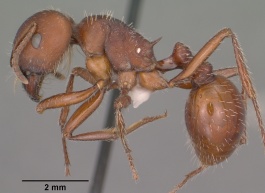 Profile of Pogonomyrmex barbatus worker |
- scape base only moderately developed, lacking conspicuous trough or concavity, lateral clypeal lobes absent or inconspicuous, basal mandibular tooth not slightly offset, gaster often (but not always) blackish (U.S., Mexico) L = 7.2-8.2 mm . . . . . Pogonomyrmex bicolor
 Head of Pogonomyrmex bicolor worker |
 Profile of Pogonomyrmex bicolor worker |
7
return to couplet #3
- propodeum unarmed (lacking spines or tubercles) . . . . . 8
- propodeum armed (with spines or tubercles) . . . . . 10
8
return to couplet #7
- mandible with less than 7 teeth, basalmost tooth strongly offset from margin, in full-face view cephalic rugae often sparse, base of antenna scape weakly developed, hardly flared (U.S., Mexico) L = 5.5-6.0 mm . . . . . Pogonomyrmex bigbendensis
 Head of Pogonomyrmex bigbendensis worker |
 Profile of Pogonomyrmex bigbendensis worker |
- lacking the above character combination . . . . . 9
9
return to couplet #8
- declivious face of propodeum without rugae or striae, color usually orange-yellow, but sometimes deep red, clypeal margin deeply excised (U.S.) L = 9.0-10.0 mm . . . . . Pogonomyrmex texanus
 Head of Pogonomyrmex texanus worker |
 Profile of Pogonomyrmex texanus worker |
- declivious face of propodeum with rugae or striae, color usually red, clypeal margin very strongly excised, sometimes almost to the frontal lobes (U.S., Mexico) L = 7.5-9.0 mm . . . . . Pogonomyrmex apache
 Head of Pogonomyrmex apache worker |
 Profile of Pogonomyrmex apache worker |
10
return to couplet #7
- lateral clypeal projections prominent, base of antenna scape with conspicuous trough or depression (U.S., Mexico) L = 6.5-8.5 mm . . . . . Pogonomyrmex tenuispinus
 Head of Pogonomyrmex tenuispinus worker |
 Profile of Pogonomyrmex tenuispinus worker |
- lateral clypeal projections absent or inconspicuous, base of antenna scape without conspicuous trough or depression (U.S., Mexico) L = 5.5-6.5 mm . . . . . Pogonomyrmex desertorum
 Head of Pogonomyrmex desertorum worker |
 Profile of Pogonomyrmex desertorum worker |
11
return to couplet #2
- with head in full-face view, sides of head behind eyes converging posteriorly, propodeum unarmed, with head in lateral view, eye located distinctly below midpoint of side of head (U.S.) L = 7.0-11.0 mm (including major) . . . . . Pogonomyrmex badius
 Head of Pogonomyrmex badius worker |
 Profile of Pogonomyrmex badius worker |
- lacking the above character combination . . . . . 12
12
return to couplet #11
- mandible with 6 teeth . . . . . 13
- mandible with 7 or more teeth . . . . . 14
13
return to couplet #12
- eye surrounded by whorled rugae (circumocular whorls), propodeum unarmed (U.S.) L= 6.0 mm . . . . . Pogonomyrmex anzensis
 Head of Pogonomyrmex anzensis worker |
 Profile of Pogonomyrmex anzensis worker |
- eye without circumocular whorls, propodeum armed (U.S., Mexico) L = 4.5-5.0 mm . . . . . Pogonomyrmex huachucanus
 Head of Pogonomyrmex huachucanus worker |
 Profile of Pogonomyrmex huachucanus worker |
14
return to couplet #12
- cephalic interrugal sculpture beaded, dorsum of petiolar node not distinctly flattened . . . . . 15
- cephalic interrugal sculpture not presenting a beaded appearance, or if beaded, then dorsum of petiolar node is distinctly flattened . . . . . 20
15
return to couplet #14
- basal mandibular tooth strongly offset from basal margin (U.S., Canada, Mexico) L = 6.5-8.5 mm . . . . . Pogonomyrmex occidentalis
 Head of Pogonomyrmex occidentalis worker |
 Profile of Pogonomyrmex occidentalis worker |
- basal mandibular tooth not strongly offset . . . . . 16
16
return to couplet #15
- eyes with circumocular whorls, dorsum of both petiolar and postpetiolar nodes with few or no rugae, propodeal spines (if present), usually little more than tubercles (in part) (U.S., Mexico) L = 6.0-9.0 mm . . . . . Pogonomyrmex maricopa
 Head of Pogonomyrmex maricopa worker |
 Profile of Pogonomyrmex maricopa worker |
- eyes without circumocular whorls, or if whorls are present, then conspicuous propodeal spines are also present, dorsum of petiolar and postpetiolar nodes usually with at least a few distinct rugae . . . . . 17
17
return to couplet #16
- alitrunk profile rather convex in outline, ventral process of petiole very well developed, ventral process of postpetiole robust (U.S.) L = 6.0 mm . . . . . Pogonomyrmex subdentatus
 Head of Pogonomyrmex subdentatus worker |
 Profile of Pogonomyrmex subdentatus worker |
- lacking the above character combination . . . . . 18
18
return to couplet #17
- frontal lobes large, broadly and evenly convex, scape base very well developed, propodeal spines (if present) short, ventral process of petiolar peduncle absent or weak (U.S.) L = 5.5-6.0 mm. . . . . Pogonomyrmex brevispinosus
 Head of Pogonomyrmex brevispinosus worker |
 Profile of Pogonomyrmex brevispinosus worker |
- lacking the above character combination . . . . . 19
19
return to couplet #18
- base of antenna scape angular and dorsum of petiolar and postpetiolar nodes with 5 or more rugae on posterior half (U.S.), length = 6.0-6.5 mm . . . . . Pogonomyrmex montanus
 Head of Pogonomyrmex montanus worker |
 Profile of Pogonomyrmex montanus worker |
- base of antenna scape rounded or angular, if angular then dorsum of petiolar and postpetiolar nodes with less than 5 distinct rugae on posterior half (U.S., Canada) L = 5.0-7.0 mm . . . . . Pogonomyrmex salinus
 Head of Pogonomyrmex salinus worker |
 Profile of Pogonomyrmex salinus worker |
20
return to couplet #14
- propodeal spines present . . . . . 21
- propodeal spines absent (tubercles at best) . . . . . 23
21
return to couplet #20
- eyes with circumocular whorls, basal face of propodeum in profile not roughly horizontal, but sloping so that alitrunk is rather broadly convex, basal margin of mandible at least weakly convex (not straight) . . . . . 22
- eye usually not surrounded by unbroken circumocular whorls, but if whorls are present then basal margin of mandible is roughly straight, basal face of propodeum in profile is almost horizontal so that alitrunk profile is not broadly convex, propodeal spines are well developed (U.S., Mexico) L = 7.0 mm . . . . . Pogonomyrmex subnitidus
 Head of Pogonomyrmex subnitidus worker |
 Profile of Pogonomyrmex subnitidus worker |
22
return to couplet #21
- dorsum of petiolar node (in profile) conspicuously flattened and covered with conspicuous rugae, propodeal spines well developed (U.S.) L = 6.5-8.0 mm . . . . . Pogonomyrmex comanche
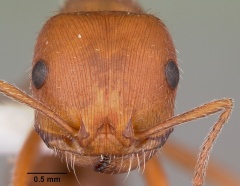 Head of Pogonomyrmex comanche worker |
 Profile of Pogonomyrmex comanche worker |
- lacking above character combination (in part) (U.S., Mexico) L = 6.0-9.0 mm . . . . . Pogonomyrmex maricopa
 Head of Pogonomyrmex maricopa worker |
 Profile of Pogonomyrmex maricopa worker |
23
return to couplet #20
- dentary margin of mandible not roughly transverse but oblique, basal tooth strongly offset from basal margin, which is short (Mexico) L = 6.5 mm . . . . . Pogonomyrmex snellingi
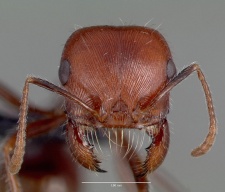 Head of Pogonomyrmex snellingi worker |
 Profile of Pogonomyrmex snellingi worker |
- lacking above character combination . . . . . 24
24
return to couplet #23
- dorsum of first gaster segment smooth and shiny (lacking shagreen), circumocular whorls few and weak, basal mandibular tooth slightly offset from margin, alitrunk in profile without conspicuous mesopropodeal depression, propodeum unarmed (U.S.) L = 4.0 mm .................... species B
- lacking above character combination . . . . . 25
25
return to couplet #24
- eye very large (eye length roughly equal to distance between eye and mandible insertion), small ants (4.7-5.2 mm) (U.S., Mexico) . . . . . Pogonomyrmex magnacanthus
 Head of Pogonomyrmex magnacanthus worker |
 Profile of Pogonomyrmex magnacanthus worker |
- eye not unusually large (eye length clearly less than distance between eye and mandible insertion) . . . . . 26
26
return to couplet #25
- cephalic interrugal areolation absent to moderate (never beaded), interrugal areolation of mesopleuron and pronotal sides very weak to absent, interrugal spaces shiny (U.S., Mexico) L = 5.5-8.7 mm . . . . . Pogonomyrmex californicus
 Head of Pogonomyrmex californicus worker |
 Profile of Pogonomyrmex californicus worker |
- cephalic interrugal areolation of head, mesopleuron, and pronotal sides moderate to strong, interrugal spaces subopaque (in part) (U.S., Mexico) L = 6.0-9.0 mm . . . . . Pogonomyrmex maricopa
 Head of Pogonomyrmex maricopa worker |
 Profile of Pogonomyrmex maricopa worker |
.
II. Key to Ephebomyrmex
1E
- dorsum of basal segment of gaster with longitudinal rugae or striae . . . . . 2E
- dorsum of basal segment of gaster without longitudinal rugae or striae . . . . . 5E
2E
return to couplet #1E
- dorsum of basal segment of gaster entirely or mostly covered by rugae or striations (Colombia, Guyana) L = 7.6-9.0 mm . . . . . Ephebomyrmex mayri (= Pogonomyrmex mayri)
 Head of Pogonomyrmex mayri worker |
 Profile of Pogonomyrmex mayri worker |
- rugae or striae of dorsum of basal segment of gaster confined to basal half of segment, sometimes found only near insertion of postpetiole . . . . . 3E
3E
return to couplet #2E
- anterior margin of clypeus convex, with small median triangular tooth (Venezuela) L = 5.0 mm . . . . . Ephebomyrmex abdominalis (= Pogonomyrmex abdominalis)
 Head of Pogonomyrmex abdominalis worker |
 Profile of Pogonomyrmex abdominalis worker |
- anterior margin of clypeus slightly excised or almost straight, but not broadly convex, margin without a small median triangular tooth . . . . . 4E
4E
return to couplet #3E
- petiole and postpetiole not massive (much of South America) L = 4.0-5.0 mm. . . . . Ephebomyrmex naegelii (= Pogonomyrmex naegelii)
 Head of Pogonomyrmex naegelii worker |
 Profile of Pogonomyrmex naegelii worker |
- petiole and postpetiole massive (southern South America) L = 4.0-4.5 mm. . . . . Ephebomyrmex abdominalis (= Pogonomyrmex abdominalis)
 Head of Pogonomyrmex abdominalis worker |
 Profile of Pogonomyrmex abdominalis worker |
5E
return to couplet #1E
- maxillary palps with 5 segments, labial palps with 4 segments . . . . . 6E
- b. maxillary palps with 4 segments, labial palps with 3 segments . . . . . 8E
6E
return to couplet #5E
- head and alitrunk yellow or reddish, but not black (Argentina, Chile) L = 4.4-4.8 mm . . . . . Ephebomyrmex odoratus (= Patagonomyrmex odoratus)
 Head of Patagonomyrmex odoratus worker |
 Profile of Patagonomyrmex odoratus worker |
- head and alitrunk black or blackish . . . . . 7E
7E
return to couplet #6E
- occiput and much of thoracic dorsum smooth, shining, few if any reticulations present, same for dorsum of petiolar node (Argentina, Chile) L = 4.5-5.0 mm . . . . . Ephebomyrmex laevigatus (= Patagonomyrmex laevigatus)
 Head of Patagonomyrmex laevigatus worker |
 Profile of Patagonomyrmex laevigatus worker |
- occiput with prominent reticulations and areolations, same for dorsum of thorax and petiolar node (Argentina, Chile) L = 4.6-6.0 mm . . . . . Ephebomyrmex angustus (= Patagonomyrmex angustus)
 Head of Patagonomyrmex angustus worker |
 Profile of Patagonomyrmex angustus worker |
8E
return to couplet #5E
- alitrunk in profile with distinct mesopropodeal depression, so that profile is not broadly convex (South America) . . . . . 9E
- alitrunk in profile without distinct mesopropodeal depression, so that profile is broadly convex . . . . . 10E
9E
return to couplet #8E
- head and alitrunk yellow, orange, or red, but not black (southern South America) L = 6.2-9.4 mm (worker), L = 12.0 mm (ergatogyne) . . . . . Ephebomyrmex cunicularius (= Pogonomyrmex cunicularius)
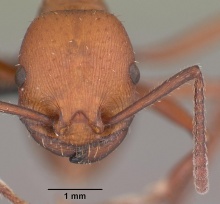 Head of Pogonomyrmex cunicularius worker |
 Profile of Pogonomyrmex cunicularius worker |
- head and alitrunk black or blackish red (Argentina) L = 5.0-7.0 mm . . . . . Ephebomyrmex brevibarbis (= Pogonomyrmex brevibarbis)
 Head of Pogonomyrmex brevibarbis worker |
 Profile of Pogonomyrmex brevibarbis worker |
10E
return to couplet #8E
- anterior margin of clypeus broadly convex, head and alitrunk blackish or blackish red, setae of dorsum of basal segment of gaster erect or semierect and black (Haiti) . . . . . 11E
- anterior margin of clypeus excised or straight, but not broadly convex, head and ali trunk yellow, red, or reddish brown, but never blackish (not Haiti) . . . . . 12E
11E
return to couplet #10E
- petiolar node in dorsal view fan-shaped or shaped like baseball catcher's mitt (rugae present but rather sparse) (Haiti) L = 5.0-5.5 mm . . . . . Ephebomyrmex saucius (= Pogonomyrmex saucius)
 Head of Pogonomyrmex saucius worker |
 Profile of Pogonomyrmex saucius worker |
- petiolar node in dorsal view miter-shaped (node covered with coarse rugae) (Haiti) L = 3.5-4.5 mm . . . . . Ephebomyrmex schmitti (= Pogonomyrmex schmitti) (and there is also a Hispaniola subspecies that was not included in Taber's key Pogonomyrmex aterrimus)
 Head of Pogonomyrmex schmitti worker |
 Profile of Pogonomyrmex schmitti worker |
12E
return to couplet #10E
- lateral clypeal projections prominent . . . . . 13E
- lateral clypeal projections absent or very weak . . . . . 14E
13E
return to couplet #12E
- propodeal spines absent, dorsum of petiolar node with little or no rugae, the surface almost smooth (Baja California) L = 3.5 mm . . . . . Ephebomyrmex laevinodis (= Pogonomyrmex laevinodis)
 Head of Pogonomyrmex laevinodis worker |
 Profile of Pogonomyrmex laevinodis worker |
- propodeal spines present, dorsum of petiolar node with conspicuous rugae (U.S., Mexico) L = 4.0-4.8 mm . . . . . Ephebomyrmex imberbiculus (= Pogonomyrmex imberbiculus)
 Head of Pogonomyrmex imberbiculus worker |
 Profile of Pogonomyrmex imberbiculus worker |
14E
return to couplet #12
- dorsum of basal segment of gaster with fine and appressed setae (lying flat or nearly so against the surface), dorsum of segment smooth and shining (not shagreened) (Argentina, Paraguay) L = 5.0 mm . . . . . Ephebomyrmex tenuipubens (= Pogonomyrmex tenuipubens)
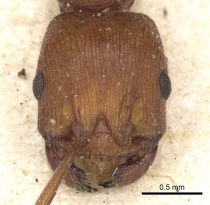 Head of Pogonomyrmex tenuipubens worker |
 Profile of Pogonomyrmex tenuipubens worker |
- setae on dorsum of basal segment of gaster erect or suberect (not appressed), dorsum of gaster at least lightly shagreened (U.S., Mexico) L = 3.5-4.0 mm . . . . . Ephebomyrmex pima (= Pogonomyrmex pima)
 Head of Pogonomyrmex pima worker |
 Profile of Pogonomyrmex pima worker |